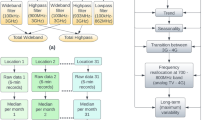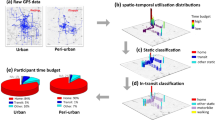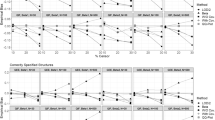Abstract
In this study, we introduced and tested a new approach to characterize residential magnetic field (MF) exposure. Short-term 20-min MF measurements were obtained by a person who carried out instantaneous spot measurements in residences. Compared to spot measurements, the 20-min measurement could potentially improve exposure assessment, because it contains information of temporal variations of MF, which have been suggested as biologically important characteristics of MF exposure. We have used this new exposure assessment method on a study of maternal MF exposure and reproductive outcomes. To validate the new method, the exposure of 30 subjects was measured with a more accurate “gold standard” method (24 h personal exposure measurements). The measures of validity used were the Spearman correlation coefficient (r), sensitivity, and specificity. We evaluated the validity of the 20-min measurements for estimating several different exposure metrics for the entire 24 h measurement period or for the hours spent at home: arithmetic mean, median, percentage of time above 0.15 μT, standard deviation, rate of change metric, standardized rate of change metric, constant field metric, and three metrics for the occurrence of high-peak exposures. The 20-min measurement was modestly associated with standard deviation and the rate of change metric, but gave very little information of other metrics of temporal variation. The 20-min measurement can also be used for assessing exposure metrics such as arithmetic mean and median, but it does not seem to offer any advantages compared to traditional ‘spot’ measurements. The 20-min measurement was not useful for assessing occurrence of high-peak exposures. We conclude that the 20-min measurement is useful for estimating some aspects of MF temporal variability.
This is a preview of subscription content, access via your institution
Access options
Subscribe to this journal
Receive 6 print issues and online access
$259.00 per year
only $43.17 per issue
Buy this article
- Purchase on Springer Link
- Instant access to full article PDF
Prices may be subject to local taxes which are calculated during checkout




Similar content being viewed by others
References
Armstrong B.K., White E., and Saracci R. Principles of Exposure Measurement in Epidemiology. Monographs on Epidemiology and Biostatistics, Vol. 21. Oxford University Press Inc., New York, 1995.
Armstrong B.G., Deadman J., and McBride M.L. The determinantants of Canadian childrens' personal exposures to magnetic fields. Bioelectromagnetics 2001: 22: 161–169.
Auvinen A., Linet M.S., Hatch E.E., Kleinerman R.A., Robison L.L., Kaune W.T., Misakian M., Niwa S., Wacholder S., and Tarone R.E. Extremely low-frequency magnetic fields and childhood acute lymphoblastic leukemia: an exploratory analysis of alternative exposure metrics. Am J Epidemiol 2000: 152 (1): 20–31.
Burch J.B., Reif J.S., Yost M.G., Keefe T.J., and Pitrat C.A. Nocturnal excretion of a urinary melatonin metabolite among electric utility workers. Scand J Work Environ Health 1998: 24(3): 183–189.
Delpizzo V., and Salzberg M.R. Relative-risk-estimate bias and loss of power in the Mantel test for trend resulting from the use of magnetic-field point-in-time (“spot”) measurements in epidemiological studies based on an ordinal exposure scale. Bioelectromagnetics 1992; 13: 363–378.
Delpizzo V., Salzberg M.R., and Farish S.J. The use of ‘spot’ measurements in epidemiological studies of the health effects of magnetic field exposure. Int J Epidemiol 1991: 20: 448–455.
Eskelinen T., Keinänen J., Salonen H., and Juutilainen J. Use of spot measurements for assessing residential ELF magnetic field exposure. A validity study. Bioelectromagnetics 2002: 23: 173–176.
Foliart D.E., Iriye R.N., Tarr K.J., Silva J.M., Kavet R., and Ebi K.L. Alternative magnetic field exposure metrics: relationship to TWA, appliance use, and demographic characteristics of children in leukemia survival study. Bioelectromagnetics 2001: 22: 574–580.
Hansen N.H., Sobel E., Davanipour Z., Gillette L.M., Niiranen J., and Wilson B.W. EMF exposure assessment in the Finnish garment industry: evaluation of proposed EMF exposure metrics. Bioelectromagnetics 2000: 21: 57–67.
Juutilainen J., Hatfield T., and Läärä E. Evaluating alternative exposure indices in epidemiologic studies on extremely low-frequency magnetic fields. Bioelectromagnetics 1996: 17: 138–143.
Kaune W.T., Darby S.D., Gardner S.N., Hrubec Z., Iriye R.N., and Linet M.S. Development of a protocol for assessing time-weighted-average exposures of young children to power-frequency magnetic fields. Bioelectromagnetics 1994: 15: 33–51.
Kaune W.T., and Zaffanella L.E. Assessing historical exposures of children to power-frequency magnetic fields. J Expo Anal Environ Epidemiol 1994: 4: 149–170.
Lee G.M., Neutra R.R., Hristova L., Yost M., and Hiatt R.A. A nested case–control study of residential and personal magnetic field measures and miscarriages. Epidemiology 2002: 13(1): 1–4.
Levallois P., Dumont M., Touitou Y., Gingras S., Mâsse B., Gauvin D., Kröger E., Bourdages M., and Douville P. Effects of electric and magnetic fields from high-power lines on female urinary excretion of 6-sulfatoxymelatonin. Am J Epidemiol 2001; 154(7): 601–609.
Li K.D., Oudouli R., Wi S., Janevic T., Golditch I., Bracken T.D., Senior R., Rankin R., and Iriye R. A population-based prospective cohort study of personal exposure to magnetic fields during pregnancy and the risk of spontaneous abortion. Epidemiology 2002: 13(1): 9–20.
Litoviz T.A., Krause D., and Mullins J.M. Effect of coherence time of the applied magnetic field on ornithine decarboxylase activity. Biochem Biophys Res Commun 1991: 178: 862–865.
Litoviz T.A., Penafiel M., Krause D., Zhang D., and Mullins J.M. The role of temporal sensing in bioelectromagnetic effects. Bioelectromagnetics 1997: 18: 388–395.
London S.J., Thomas D.C., Bowman J.D., Sobel E., Cheng T-C., and Peters J.M. Exposure to residential electric and magnetic fields and risk of childhood leukemia. Am J Epidemiol 1991: 134: 923–937.
McDevitt J.J., Breysse P.N., Bowman J.D., and Sassone D.M. Comparison of extremely low frequency (ELF) magnetic field personal exposure monitors. J Expo Anal Environ Epidemiol 2002: 12(1): 1–8.
Morgan M.G., Nair I., and Zhang J. A method for assessing alternative effects functions that uses simulation with EMDEX data. Bioelectromagnetics 1995: 16(3): 172–177.
Neutra R.R., and Delpizzo V. A richer conceptualization of “exposure” for epidemiological studies of the “EMF-mixture”. Bioelectromagnetics 2001: 5(Suppl): S48–S57.
Rankin R.F., Bracken T., Senior R.S., Kavet R., and Montgomery J.H. Results of a multisite study of U.S. residential magnetic fields. J Expo Anal Environ Epidemiol 2002: 12: 9–20.
Rothman K.J., and Greenland S. Modern Epidemiology, 2nd ed. Lippincot-Raven Publishers, Philadelphia, PA, 1998.
Schoenfeld E.R., Henderson K., O'Leary E., Grimson R., Kaune W., and Leske M.C. Magnetic field exposure assessment: a comparison of various methods. Bioelectromagnetics 1999: 20: 487–496.
Schuz J., Grigat J-P., Störmer B., Rippin G., Brinkmann K., and Michaelis J. Extremely low frequency magnetic fields in residences in Germany. Distribution of measurements, comparison of two methods for assessing exposure, and predictors for the occurrence of magnetic fields above background level. Radiat Environ Biophys 2000: 39: 233–240.
van der Woord M.P., Kromhout H., Barregard L., and Jonsson P. Within-day variability of magnetic fields among electric utility workers: consequences for measurement strategies. AIHAJ 1999: 6: 713–719.
Villeneuve P.J., Agnew D.A., Corey P.N., and Miller A.B. Alternate indices of electric and magnetic field exposures among Ontario electrical utility workers. Bioelectromagnetics 1998: 19: 140–151.
Yost M.G., Lee G.M., Duane B.D., Fisch J., and Neutra R.R. California protocol for measuring 60 Hz magnetic fields in residences. Appl Occup Environ Hygiene 1992: 7: 772–777.
Yost M. Alternative magnetic field exposure metrics: occupational measurements in trolley workers. Radiat Prot Dosim 1999: 83: 99–106.
Zaffanella L.E., and Kalton G.W. Survey of personal magnetic field exposure: 1000-person survey. EMF RAPID Engineering Project ♯6 Final Report, Enertech Consultants, 1998.
Acknowledgements
We thank Dr. Pia Verkasalo from the National Public Health Institute for her valuable comments, and Mr. Toni Patama from the University of Kuopio for his contribution in preparing MF exposure data for statistical analysis.
Author information
Authors and Affiliations
Corresponding author
Rights and permissions
About this article
Cite this article
Eskelinen, T., Niiranen, J. & Juutilainen, J. Use of short-term measurements for assessing temporal variability of residential ELF magnetic field exposure. J Expo Sci Environ Epidemiol 13, 372–377 (2003). https://doi.org/10.1038/sj.jea.7500283
Received:
Accepted:
Published:
Issue Date:
DOI: https://doi.org/10.1038/sj.jea.7500283
Keywords
This article is cited by
-
Indoor transformer stations and ELF magnetic field exposure: use of transformer structural characteristics to improve exposure assessment
Journal of Exposure Science & Environmental Epidemiology (2014)
-
Accuracy of short-term residential measurement in the prediction of 72-h exposure to power frequency magnetic field in households very close to high-tension transmission lines
Journal of Exposure Science & Environmental Epidemiology (2007)



